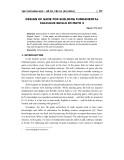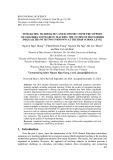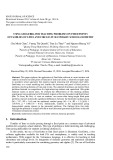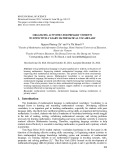
168
HNUE JOURNAL OF SCIENCE
Educational Sciences 2024, Volume 69, Issue 5B, pp. 168-178
This paper is available online at http://hnuejs.edu.vn/es
DOI: 10.18173/2354-1075.2024-0145
APPLYING TECHNOLOGY TO ONLINE MATHEMATICS EDUCATION
IN THE DIGITAL ERA
Tran Thanh Binh*, Bui Thi Thom and Dang Tung Long
Mathlish Company Limited, Hanoi city, Vietnam
*Corresponding author: Tran Thanh Binh, e-mail: tranbinhmathlish@gmail.com
Received May 18, 2024. Revised November 10, 2024. Accepted December 27, 2024.
Abstract. In the context of technological and educational advancement, the integration of
technology and online platforms has yielded significant impacts on online pedagogical
methodologies. This report presents the application of the online teaching software Classin,
which has elicited positive and innovative changes in Mathlish’s online math classes. By
harnessing Classin's interactive features, Mathlish educators created an engaging and student-
centered learning environment. The report emphasizes the integration of features and
inspiration from televised educational programs into Mathlish's online math classes, aiming
to provide captivating learning experiences for students. Furthermore, the report examines
how Classin's real-time feedback mechanisms enhance personalized learning and global
connectivity. Ultimately, the harmonious integration of Classin's features into the
instructional process within Mathlish's online math classes underscores the essential role of
technology in the online education model, thereby equipping learners with vital skills in the
digital age.
Keywords: online learning, educational technology, personalized learning, student
engagement, adaptive instruction.
1. Introduction
In the current era of rapid technological advancement, the global landscape of education is
undergoing a profound transformation. Recent studies have demonstrated that digital technologies
are reshaping educational paradigms [1], particularly in STEM fields [2]. The adoption of virtual
learning environments has become increasingly significant [3], with research showing substantial
impacts on educational delivery and outcomes. This transformation is particularly evident in
mathematics education, where digital tools and platforms have shown promising results [4], [5].
Mathlish Education builds upon established frameworks in technology-enhanced learning [6],
providing innovative online mathematics education for students of various age groups. Research
has shown that age-appropriate digital interventions [7] and interactive technologies [8]
significantly impact learning outcomes. Studies by Le and Vu [9] have demonstrated that real-
time feedback in online mathematics courses can enhance student engagement and understanding,
supporting Mathlish's approach to digital mathematics instruction.
The utilization of Classin as a modern online instructional software aligns with contemporary
research on effective digital learning platforms [10]. Nguyen et al.'s study specifically
demonstrated Classin's effectiveness in teaching algebra online in Vietnamese contexts. The

Applying technology to online mathematics education in the digital era
169
importance of interactive whiteboards and collaborative tools [11], [12] supports Mathlish's
integration of diverse technological features. Research by Miller and Glover [8] emphasizes that
the flexible adaptation of technology for specific educational objectives is crucial for successful
implementation.
Studies have consistently shown that online mathematics instruction can be particularly
effective when properly implemented [13], [14]. The integration of real-time feedback systems [15]
and interactive learning environments [16] has been demonstrated to enhance student engagement
and achievement. Through platforms like Classin, research has documented the benefits of
synchronized learning experiences and collaborative digital environments [17], [18].
The foundation of this exploration rests on a meticulous survey of over 1000 participants,
building upon established methodologies in educational research [19]. This approach aligns with
analytical frameworks for online learning environments [20] while introducing new insights into
mathematics education. The survey methodology follows validated practices for online
educational research [21], ensuring robust data collection and analysis.
This study contributes to the existing body of knowledge by examining how specialized
platforms can enhance mathematics education through personalized learning approaches [22] and
gamified elements [23], [24]. By integrating findings from virtual manipulatives research [25]
and adaptive learning technologies [6], this report provides valuable insights into the evolving
landscape of digital mathematics education.
2. Content
2.1. The role of technology in online education
The application of technology in education has been extensively studied, revealing its
transformative potential in enhancing engagement, comprehension, and accessibility. Research
highlights the integration of Learning Management Systems (LMS) as a cornerstone of modern
online education.
One study by Kim and her co-workers demonstrated the benefits of LMS platforms in
mathematics education [21]. The researchers found that LMS equipped with multimedia resources
and asynchronous learning capabilities significantly improve student outcomes compared to
traditional methods. The LMS allows for the integration of dynamic, interactive content that caters
to diverse learning preferences, leading to enhanced student engagement and comprehension of
mathematical concepts.
Additionally, the integration of interactive whiteboards has been shown to have significant
pedagogical benefits. Miller and Glover emphasize the ability of these digital tools to facilitate
dynamic visualization of complex mathematical concepts, fostering deeper student understanding [8].
The interactive nature of the whiteboards enabled teachers to engage students in more active,
hands-on learning, moving beyond passive information transmission.
Furthermore, the use of virtual manipulatives has been identified as a crucial component of
online math education. Reimer and Moyer found that these digital tools for manipulating
mathematical concepts enhance students' spatial reasoning and problem-solving skills, surpassing
traditional pen-and-paper approaches [5]. By providing students with the ability to interact with
and explore mathematical representations in a virtual environment, virtual manipulatives address
the need for hands-on, experiential learning in the online setting.
These findings underscore the importance of leveraging a variety of digital tools and
technologies to provide engaging, interactive, and accessible learning experiences for students in
the field of online mathematics education. The integration of LMS, interactive whiteboards, and

Tran TB*, Bui TT & Dang TL
170
virtual manipulatives has the potential to transform the way mathematics is taught and learned,
catering to diverse learning styles and promoting deeper conceptual understanding.
2.2. Personalized learning through real-time feedback
The advent of real-time feedback mechanisms has introduced new dimensions to
personalized learning in online mathematics education. Researchers have explored the potential
of these technologies to enhance student learning outcomes.
One study conducted by Nguyen and his collaborators in 2019 investigates the use of real-
time feedback in online math courses [10]. The researchers concluded that providing immediate
responses to student inputs significantly improves their comprehension and retention rates. By
receiving immediate feedback on their performance and understanding, the surveyed students
were able to address misunderstandings and consolidate their learning more effectively. This real-
time interaction facilitated a more personalized learning experience, catering to the unique needs
and pacing of each student.
Furthermore, Le led a team exploring the impact of adaptive learning technologies in online
mathematics education [6]. These researchers highlight the ability of adaptive systems to tailor
the educational experience to individual student needs, thereby maximizing learning efficiency.
Adaptive technologies use data-driven algorithms to continuously assess student progress and
adjust the content, difficulty level, and instructional strategies accordingly. This personalized
approach ensures that students receive the appropriate level of challenge and support, maintaining
their engagement and fostering their mastery of mathematical concepts.
These studies align with the analytics-driven approach to education proposed by Siemens
and Long [20]. This framework emphasizes the use of data to inform instructional strategies and
create responsive learning environments. By incorporating real-time feedback and adaptive
technologies, educators can leverage data-driven insights to promptly identify and address student
challenges, ultimately enhancing their overall learning experience and outcomes.
The integration of real-time feedback and adaptive learning technologies in online
mathematics education represents a significant shift towards personalized, data-driven
instruction. These advancements have the potential to transform the way students engage with
and master mathematical content, catering to their individual learning needs and preferences. As
the field of educational technology continues to evolve, the application of these innovative
approaches can contribute to the ongoing efforts to improve the quality and accessibility of online
mathematics education.
2.3. Gamification and student engagement
Gamification has emerged as a powerful tool for enhancing student engagement in online
mathematics education. Research has shown that the incorporation of game-based elements can
have a significant impact on student motivation and learning outcomes.
A study conducted by Pham [26] demonstrates that incorporating game-based elements into
mathematics instruction significantly enhances student motivation and participation. By
introducing elements such as scoring systems, leaderboards, and interactive challenges, the
researchers were able to create a more immersive and engaging learning environment. This
gamified approach taps into students' intrinsic desires for competition, achievement, and
exploration, leading to increased levels of active engagement and persistence in the learning process.
Similarly, Tran and some researchers [27] found that gamified learning environments
promote active involvement and collaborative problem-solving in online mathematics education.

Applying technology to online mathematics education in the digital era
171
The researchers noted that the game-based elements transformed the learning experience from
passive reception to active exploration. The students were more inclined to work together, share
strategies, and collectively solve mathematical problems, fostering a sense of community and
promoting deeper conceptual understanding.
The integration of gamification in online mathematics education represents a significant shift
towards engaging, personalized, and data-driven instruction. As the field of educational
technology continues to evolve, the application of these innovative approaches can contribute to
the ongoing efforts to improve the quality and accessibility of online mathematics learning.
2.4. The evolution of online math education
Recent studies have highlighted the evolving nature of online math education, with a focus
on incorporating cutting-edge technologies to enhance learning outcomes. These advancements
align with global trends in education, where technology serves not only as a tool but as an integral
component of the learning process.
Research has emphasized the role of artificial intelligence (AI) in personalizing instruction
and providing targeted interventions. Nguyen et al. [3] explore the potential of AI-driven
platforms to adapt the learning experience to the unique needs and preferences of individual
students. By leveraging machine learning algorithms, these systems can continuously monitor
student progress, identify areas of difficulty, and deliver personalized content, feedback, and
support. This AI-powered approach to online mathematics education has the potential to
dramatically improve learning outcomes by ensuring that each student receives the appropriate
level of challenge and scaffolding.
Alongside the integration of AI, researchers have also explored the potential of augmented
reality (AR) in creating immersive educational experiences. A team led by Wu [1] investigated
the use of AR in the teaching of abstract mathematical concepts. By superimposing digital
visualizations and interactive elements onto the physical environment, AR can help students better
understand and engage with complex ideas. This technology-enabled approach to mathematics
instruction can be particularly beneficial in the online setting, where the lack of physical
manipulatives and hands-on activities can pose a challenge.
These advancements in online mathematics education, including the incorporation of AI-
driven personalization and AR-enhanced visualizations, represent a holistic approach to
addressing the challenges and opportunities of remote learning. By seamlessly integrating cutting-
edge technologies into the learning process, educators can create more engaging, responsive, and
accessible online environments that cater to the diverse needs of students.
2.5. Challenges and future directions
Despite the promising potential of technology in education, challenges persist. Issues such
as digital equity, teacher training, and the need for robust infrastructure continue to impede
widespread adoption. Paterson and his colleagues in 2019 emphasized the importance of
professional development for educators to effectively integrate technology into their teaching
practices [18]. Moreover, the need for high-quality, culturally relevant digital content remains a
pressing concern, particularly in diverse educational contexts.
Future research should focus on addressing these challenges while exploring innovative
applications of technology to enhance learning experiences. By building on existing theories and
practices, educators and policymakers can develop strategies to ensure that the benefits of online
education are accessible to all learners.

Tran TB*, Bui TT & Dang TL
172
2.6. Methods and results
2.6.1. Research methodology
The study employed a mixed-methods approach, combining quantitative and qualitative
methodologies. An extensive survey questionnaire was administered to more than 1000
participants enrolled in Mathlish's online mathematics courses on the Classin platform.
Quantitative data were collected through Likert-scale questions, capturing participants'
perceptions of engagement, comprehension, and the impact of technology integration. Qualitative
data were gathered through open-ended questions, enabling participants to provide nuanced
insights into their learning experiences. The collected data were analyzed using descriptive
statistics for quantitative responses and thematic analysis for qualitative responses.
2.6.2. Results of the study
Quantitative analysis of the survey responses revealed that 92% of participants reported a
notable increase in engagement levels due to the incorporation of interactive Classin features.
Additionally, 88% of participants acknowledged an enhancement in comprehension, attributing
it to the immersive learning environment facilitated by 3D visualizations and virtual
manipulatives. In terms of personalized learning, 85% of participants felt that Classin's real-time
feedback mechanisms aided their understanding and progress.
Qualitative analysis unveiled common themes among participants' feedback. Many students
expressed enthusiasm for the dynamic classroom environment created by Mathlish and Classin.
The integration of game show elements was particularly praised, with 95% of students noting that
it made learning engaging and fostered healthy competition. Over 90% of Mathlish educators
reported that the interactive features of Classin helped in addressing individual learning needs and
adapting instruction in real time.
* Increased Student Participation
- Before integration (75%): The number of students participating in the class is 75%,
indicating a moderate level of student engagement.
- After classin (90%): The increase to 90% post-Classin signifies a significant improvement,
indicating heightened engagement and interest in online math classes.
Table 1. Student participation
Stage
Percentage
Before Integration
75%
After Classin
90%
Discussion: The integration of Classin resulted in a substantial improvement in student
attendance, underlining the platform's efficacy in enhancing student participation and overall
class engagement.
* Improved Knowledge Retention
- Before Integration (60%): The initial 60% knowledge retention implies a moderate grasp
of concepts.
- After Classin (80%): The improvement to 80% post-Classin indicates that Classin's
interactive features contributed to enhanced knowledge retention, showcasing the technology's
effectiveness in reinforcing learned concepts.
Table 2. Knowledge retention
Stage
Percentage
Before Integration
60%
After Classin
80%

























![Quyển ghi Xác suất và Thống kê [chuẩn nhất]](https://cdn.tailieu.vn/images/document/thumbnail/2025/20251030/anh26012006/135x160/68811762164229.jpg)
